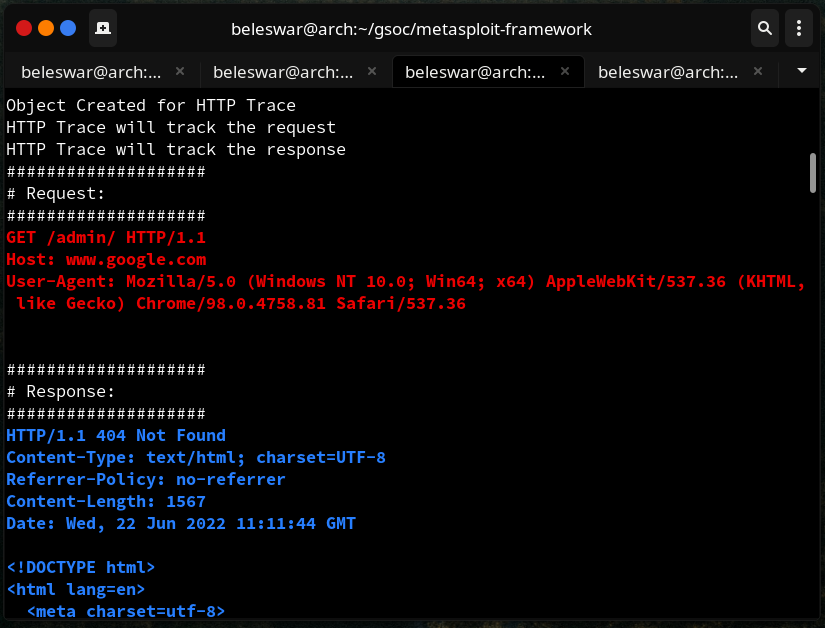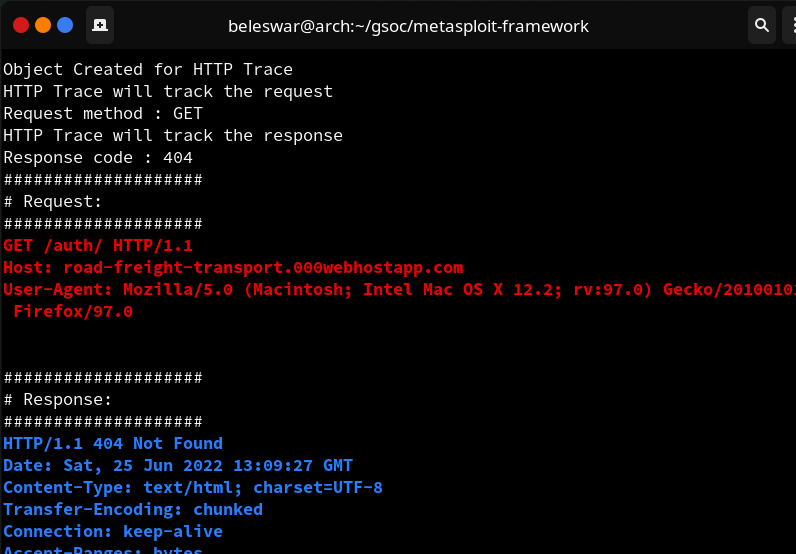This article summarizes the work done during the second week of the coding period of Google Summer of Code. The primary work done during this week was to create a wrapper class for HTTP-Trace at the Rex::Proto::Http library and establish the connection between this class with Rex::Proto::Http::Client and Rex::Proto::Http::Server, to enable the tracking of requests and responses.
As mentioned in my last blog post, the optimal location for implementing HTTP-Trace was determined to be in the _send_recv() method for Rex::Proto::Http::Client, and in the on_client_data() and send_response() methods for Rex::Proto::Http::Server. These methods will create an object of the wrapper class and call the wrapper class’s methods through the object. Thus, the work for this week was to create the wrapper class and define some initial functionalities in its methods. Let’s continue and look at the work done in detail. Here is the link to my project on the GSoC site: Project
PR Workstyle
We decided to work on my fork of rapid7/metasploit-framework. A branch GSoC-add-Http-Trace was created on my repository: 3V3RYONE/metasploit-framework, which aims to hold all the changes done for my project. We decided to create feature branches on my repo to implement specific functionalities such as create-wrapper-class, add-HTTP-Trace, etc. The idea is to create a pull request from these unique feature branches to the central GSoC-add-Http-Trace branch on my repo. So, after all the features related to my GSoC project are merged, we make the final pull request from GSoC-add-Http-Trace branch on my repo to the master branch on rapid7/metasploit-framework. This will allow us to track our work better since we can easily review changes done in the single feature branch PRs, and then create a single final pull request at the end to the mainstream repo will be convenient for maintainers to overview the whole GSoC work in a single PR, rather than targeting all PRs at the rapid7 repo which would have resulted in a number of smaller PRs containing incomplete work.
Task 1: Creating the wrapper class
Now, we have a name to our wrapper class: Rex::Proto::Http::HttpTrace. Currently, it has 2 methods (use_http_trace_request() and use_http_trace_response()) and the class constructor initialize(). As the name suggests, use_http_trace_request() is used for tracking the HTTP request passed to it as parameter and use_http_trace_response() is used to track the HTTP response passed to it as parameter.
As a part of the initial implementation, the initialize() method just prints a static message saying “Object has been created for HTTP-Trace”, and the other two methods print the static messages “HTTP-Trace will track the request” and “HTTP-Trace will track the response” respectively. Although the messages aren’t much informative, this step was important as we had to first ensure that a connection could be successfully established whenever the object of the class is initialized or methods of the class are called through the object.
 |
| Figure 1: Code example showing initial implementation done in |
| Rex::Proto::Http::HttpTrace |
Task 2: Establishing the connection between wrapper class and Client and Server
After the initial wrapper class was created, the next task was to utilize this wrapper class’s functionality in the Client and Server library files, i.e. to establish the connection between those classes. This was done by creating an object of the Rex::Proto::Http::HttpTrace class in Rex::Proto::Http::Client and Rex::Proto::Http::Server and calling the methods of the Rex::Proto::Http::HttpTrace class for tracking requests and responses by passing appropriate parameters.
Thus, to establish the connection between Rex::Proto::Http::HttpTrace and Rex::Proto::Http::Client, the object of Rex::Proto::Http::HttpTrace was created (named http_trace_object) in the _send_recv() method of Rex::Proto::Http::Client, and the use_http_trace_request() and use_http_trace_response() methods were invoked through this object. Similarly, to establish the connection between Rex::Proto::Http::HttpTrace and Rex::Proto::Http::Server, the object of Rex::Proto::Http::HttpTrace was created (named http_trace_object) in two methods (on_client_data() and send_response()) of Rex::Proto::Http::Server, and the use_http_trace_request() and use_http_trace_response() methods were invoked through this object.
 |
| Figure 2: Code example showing object creation of |
| Rex::Proto::Http::HttpTrace class in Rex::Proto::Http::Client |
 |
| Figure 3: Code example showing object creation of |
| Rex::Proto::Http::HttpTrace class in Rex::Proto::Http::Server |
The connection was successful and it was verified through the output (see Figure 4). That is, now the Client and Server can successfully make a call to the HTTP-Trace wrapper class for tracking their requests and responses.
 |
| Figure 4: Image showing the initial output of HTTP-Trace functionality |
| which verifies the established connection |
Task 3: Improvements
Now that I was sure the connection between Rex::Proto::Http::HttpTrace, Rex::Proto::Http::Client, and Rex::Proto::Http::Server was established, I worked upon giving a more relevant and meaningful definition to the use_http_trace_request() and use_http_trace_response() methods of the wrapper class. The initialize() method now takes the datastore parameters like HttpTrace, HttpTraceHeadersOnly and HttpTraceColors. The HttpTrace parameter stores a boolean denoting whether HttpTracing is enabled in msfconsole. HttpTraceHeadersOnly parameter stores a boolean flag denoting whether only the HTTP Headers should be printed to the console. The HttpTraceColors parameter stores a string which denotes the pair of colors (separated by a /), to be used for printing requests and responses intuitively.
Next, instance variables were created and were used to store these parameters. Instance variables ensure that we can use their value anywhere in the Rex::Proto::Http::HttpTrace class, for the current object in scope. This means the value of these parameters would be unique for every object of the Rex::Proto::Http::HttpTrace class created. This improvement also ensures that whenever an object is created for HttpTrace wrapper class, we have the datastore options related to HTTP-Trace ready, and we need not repeatedly pass these options while making a function call now.
 |
Figure 5: Code example showing improvements in the initialize() method |
| of Rex::Proto::Http::HttpTrace |
Also, the two methods (use_http_trace_request and use_http_trace_response) of the wrapper class were defined in a better fashion. Now, instead of printing static messages, we are trying to print some information related to the request and response. First, we check the value of the instance variable @http_trace, if it’s set to true, then only the static messages are printed, else they are not. Along with the static messages, we are printing the request method in case of request tracking and the response code in case of response tracking. This was done by accepting an additional parameter method/code for request/response respectively. This also removed the redundant parameter colors as we need not pass it every time the method is called.
 |
| Figure 6: Code example showing improvements in |
use_http_trace_request() and use_http_trace_response() |
| methods of Rex::Proto::Http::HttpTrace |
 |
| Figure 7: Image showing the revised output of HTTP-Trace functionality |
All the work discussed above has been implemented in the feature branch create-wrapper-class-Week2of my repo. The pull request from the feature branch to the central GSoC branch was then reviewed by my mentor, following which it was merged into the central branch. You may see the pull request to look at the entire code of the wrapper class.
Note
Currently, the requests and responses are directly not printed to the console in the methods of Rex::Proto::Http::HttpTrace wrapper class because the HttpTrace datastore option is implemented in the Exploit::Remote::HttpClient mixin. So, now, even if we set HTTP-Trace=false in msfconsole, we would still get the requests and responses tracked to msfconsole because the datastore option does not point to the Rex::Proto::Http::HttpTrace wrapper class now. Thus, the full functionality of printing requests and responses isn’t implemented now in HTTP-Trace methods to prevent this anomaly, and they will be implemented once the datastore options have been ported from Exploit::Remote::HttpClient to Rex::Proto::Http::Client.
Conclusion
It’s a wrap for Week 2 :) The Rex::Proto::Http::HttpTrace wrapper class created here lays the base for the additional functionalities to be added in upcoming weeks. This also successfully established the connection between HttpTrace class with the Rex::Proto::Http::Client and Rex::Proto::Http::Server class. Thus, our next plan in Week 3 is to implement the full HTTP-Trace functionalities in the use_http_trace_request() and use_http_trace_response() methods of the Rex::Proto::Http::HttpTrace wrapper class and implement the datastore options in the Rex::Proto::Http::Client and Rex::Proto::Http::Server to make msfconsole work with the HttpTrace wrapper class.
Catch you up in the third week! :)